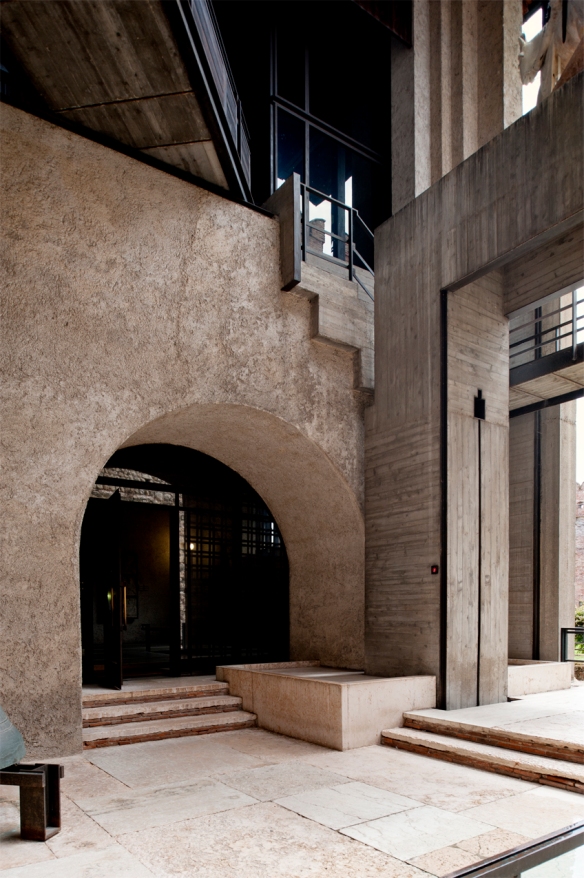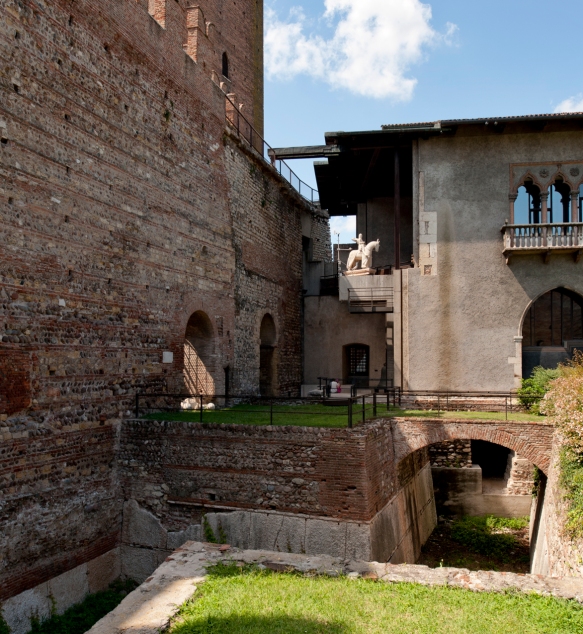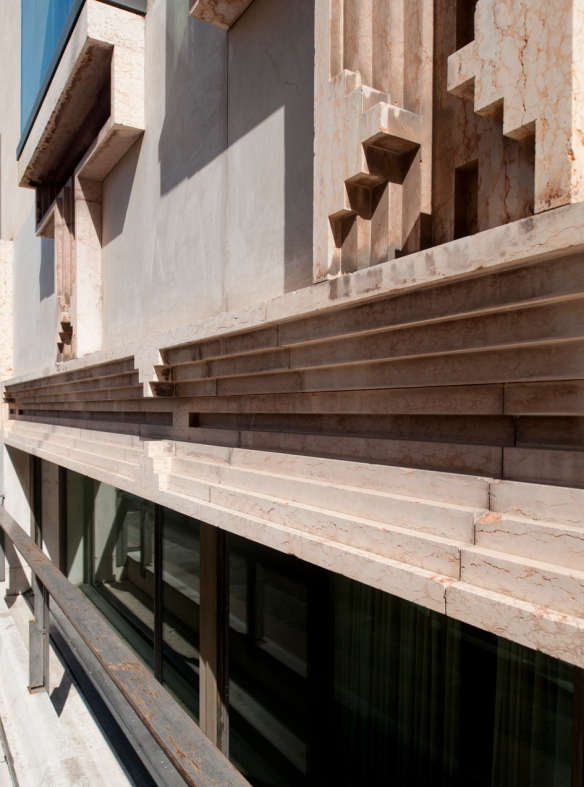In my last post, I featured a few images of the exterior of the Castelvecchio in Verona. For this post, I’ll focus mostly on its interior, and show a few images of another Scarpa building in Verona, the Banca Popolare di Verona (which I was unfortunately forbidden to enter). As a disclaimer for those that get bored with images of buildings, this post may be a little architecture-centric. Not to worry, though, I still have a backlog of two more posts after this one, which I will be publishing in the next few days.
Castelvecchio was built in the middle of the 14th Century by Cangrande II, a ruthless local ruler, and after Verona fell to Napoleon, and then the Austrians, it was further used as a barracks and for ammunition storage. In the Fascist period, it underwent a number of renovations that restored it to a version of a Medieval castle that designers at the time thought appropriate, converting it into a museum. However, some strange moves were made, like salvaging gothic windows from nearby houses for use on the facade of the former barracks. The castle was bombed during World War II, and was afterwards again restored similarly. In the 1960s, a progressive museum director was hired, and he soon hired Carlo Scarpa to renovate the entire museum complex.
According to Scarpa, when he was hired, the Castelvecchio was completely fake. The previous renovations of the past forty years were fantasy constructions to make the place appear like an intact medieval castle. Damaged frescoes, which were missing large chunks, were filled in, and all of the new work done was designed to blend in with the old. Artifacts and paintings were displayed how some curator thought they might have been hung in the fourteenth century.
Rather than continuing in this mode, what Scarpa did here was quite revolutionary at the time, and remains influential to this day. His concept was to expose the various layers of construction, and to clearly delineate new interventions from old. Although subtle by today’s standards, his introduction and celebration of concrete and steel within the brick and stone walls of the castle was groundbreaking. Rather than attempting to blend in with the existing building, his details clearly separated his work form the old, almost making it float above in some cases.
The pictures probably do a better job of explaining it than I do, so here they are (click to enlarge):

In the sculpture gallery, Scarpa left the backdrops spare. One of his consistent obsessions was the connections between different surfaces. Here, the concrete floors are rimmed with a limestone channel at the joint with the vertical walls, which accentuates the relationship between existing and new.

The space towards which this woman is walking, off of the sculpture wing, is the only modern appendage that penetrates the facade. Called the Saracellum, it sits as a pristine box in the interior garden, and brings natural light from above to highlight medieval artifacts from the castle's original inhabitants. Notice how Scarpa challenges the symmetry of the window above (the faux non-original gothic windows mentioned at the top of the page).

Not only did he design the renovation, Scarpa also designed every display stand in the museum. Here, the Master of Sant'Anastasia's crucifixion group gets the Scarpa treatment. Also notice connection between ceiling and walls, where a small shadow-line is created. Also of note is the steel girder that spans in the direction of movement through the galleries, which is offset form the ceiling.

At the pivotal intersection of the east and west wings of the castle with the ancient town walls and bridge, Scarpa demolished a portion of the rebuilt east wing, and created this area, where all of the circulation paths come together. The focal point is on an equestrian statue of Cangrande, which is on display above.

The wall that the bridge above penetrates is believed to have been an original town wall, which was later incorporated into the castle and bridge across the Adige (photographed in yesterday's post).

The bridge across the Adige, which is open to the public, is accessed by the walkway above, which extends through the castle to the river. The museum circulation is under this bridge, and then above it later in the journey through the castle.

Museum-goers are constantly confronted with juxtapositions of old and new, interior and exterior, as they move through the complex.

Each joint is an opportunity for expression. Notice how the direction of the wooden formwork was changed at this point.

Back in the intersection with the Cangrande statue, each change of use, structure, or material is clearly delineated.

Again, textural changes were incredibly important to Scarpa. Notice how the sill, which is a slab of polished limestone, is inset form the edge, clearly expressing its difference.

Scarpa also designed each of the frames, which are in stark contrast to those that are usually seen on paintings of this era.

Rather than just hanging the paintings on the walls, they are displayed in three dimensions, taking advantage of certain natural lighting features, and also taking up the space of the gallery. The frescoes on these walls were a source of particular consternation for Scarpa. They had been restored in the fascist period, and the gaps had been painted in. Scarpa meticulously removed any portions that were not original.

What an unfortunately placed exit sign, presumably installed recently. The altarpiece doors are hung by their hinges.

Scarpa abhorred symmetry, which is exemplified by his placement and framing of Nicola Giolfino's Triumph of Pompey.

The easels on which many of the paintings are displayed were first used in the Correr Museum in Venice, and repurposed here.

The clock tower was actually renovated by one of Scarpa's disciples, Giuseppe Tommasi, and was only opened in 2010. The floors are supported by exposed struts that can be seen from the courtyard. Separated from Scarpa's interventions by the walk along the ramparts, this is a pretty sympathetic, minimal-impact renovation.

Scarpa created this walkway along the riverfront ramparts that gives views across the water, but also a close-up look at how the various layers of the building come together.

Cangrande's statue is meant to be approached from all angles. Here, a bridge over the area that I showed in some photographs above gives the first eye-level view.

You may need to click on this image to enlarge it in order to see, but Cangrande has an enormous smile on his face. He was the ruler responsible for bringing Dante and other luminaries to Verona, and ushering in an era of prosperity. His son, Cangrande II, was responsible for building this castle, and is credited with none of the positive attributes of his father. The castle was built for the ruthless ruler to keep out Veronese, not foreign invaders.

Again, the somewhat sparse surroundings and spare frames help visitors focus on the artwork (non-architects, at least). Here Girolamo Dai Libri's Modonna of the Parasol gets some star treatment.

This section is devoted to Tintoretto and Veronese. It's a little shocking to see these displayed in a non-climate controlled environment, and I wonder how long it will be before air conditioning is introduced.

The Banca Popolare di Verona, designed by Scarpa later in life, is unfortunately almost impossible to enter. No amount of pleading convinced the bank officials to let me in, although a Spanish architect that I met at the Castelvecchio told me that he was able to get in for ten minutes after three days of begging.



















If only you had three more days to beg to get into the bank building!! Anyway, how do people do their banking in the Banca Popolare di Verona if they don’t let you in. Is online banking that popular there?
It’s actually a bank office building. The public entry is an older building next door.
wow. the Castelvecchio is as complex as it is beautiful.
I was in castelvecchio this weekend, and I was so impressed with the work of this architect.. visitor can to enjoy the building in all its dimensions. Amazing and and unforgettable.
I’m glad that you enjoyed the building as much as I did.
Very good blog and article…i’m interested to see that sculpture of Cangrande
Pingback: Семнадцать шедевров от Рубенса до Тинторетто, похищенных в Вероне, нашли под Одессой | Заповедник
Fantastic photographs and blog. I was in the bank during construction but not since. I wonder if I could use one of your Banca Popolare photos in my new book. Please let me know, Mark Hewitt, FAIA, USA.
HI, Mark. I’m happy to let you use the photo. Please reach out to me at tjusczyk@archiphernalia.com. Thanks!